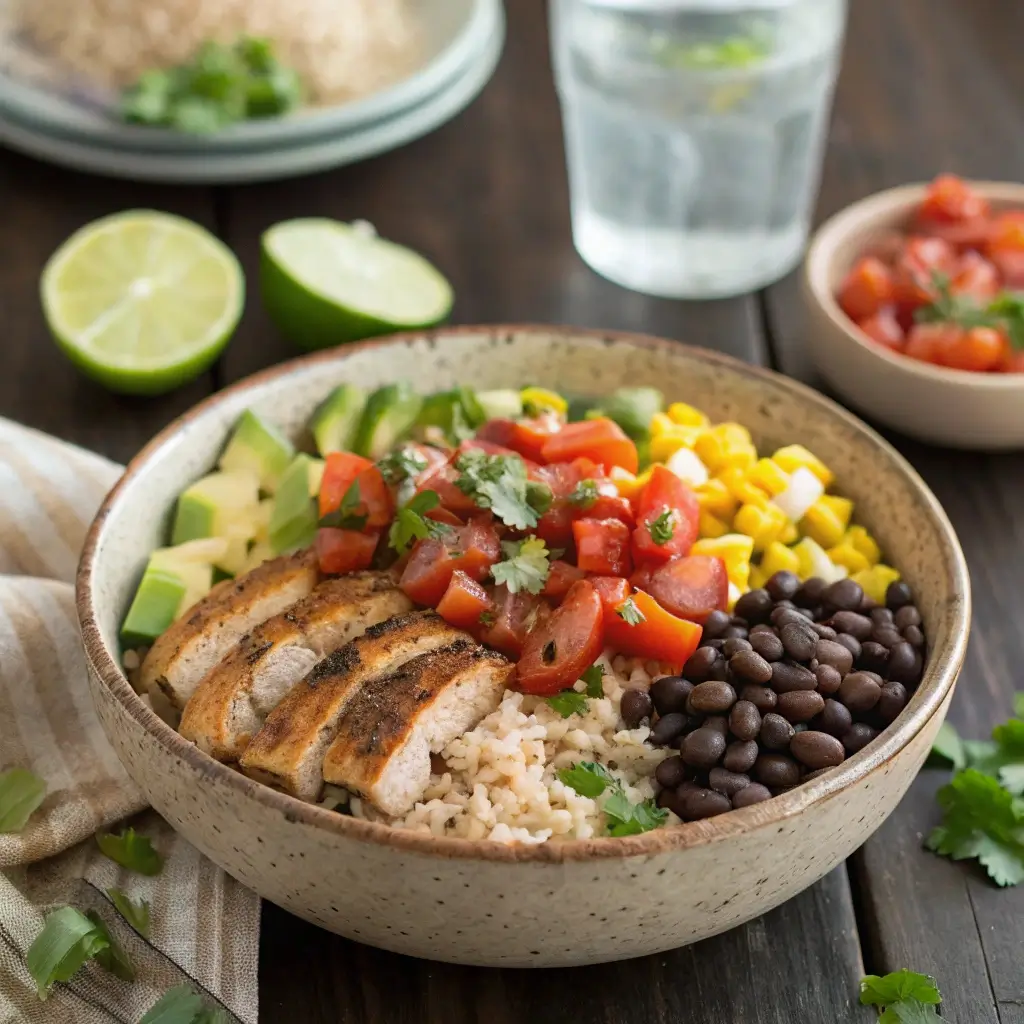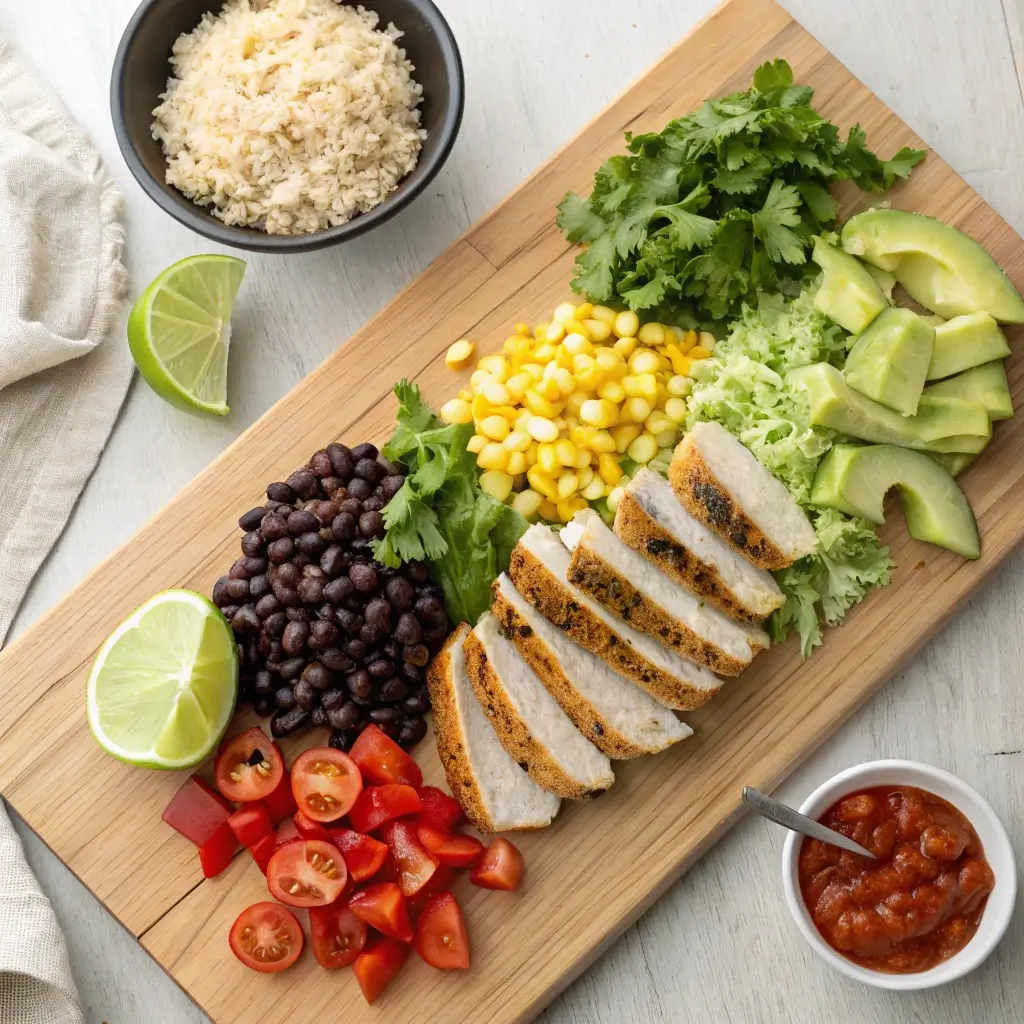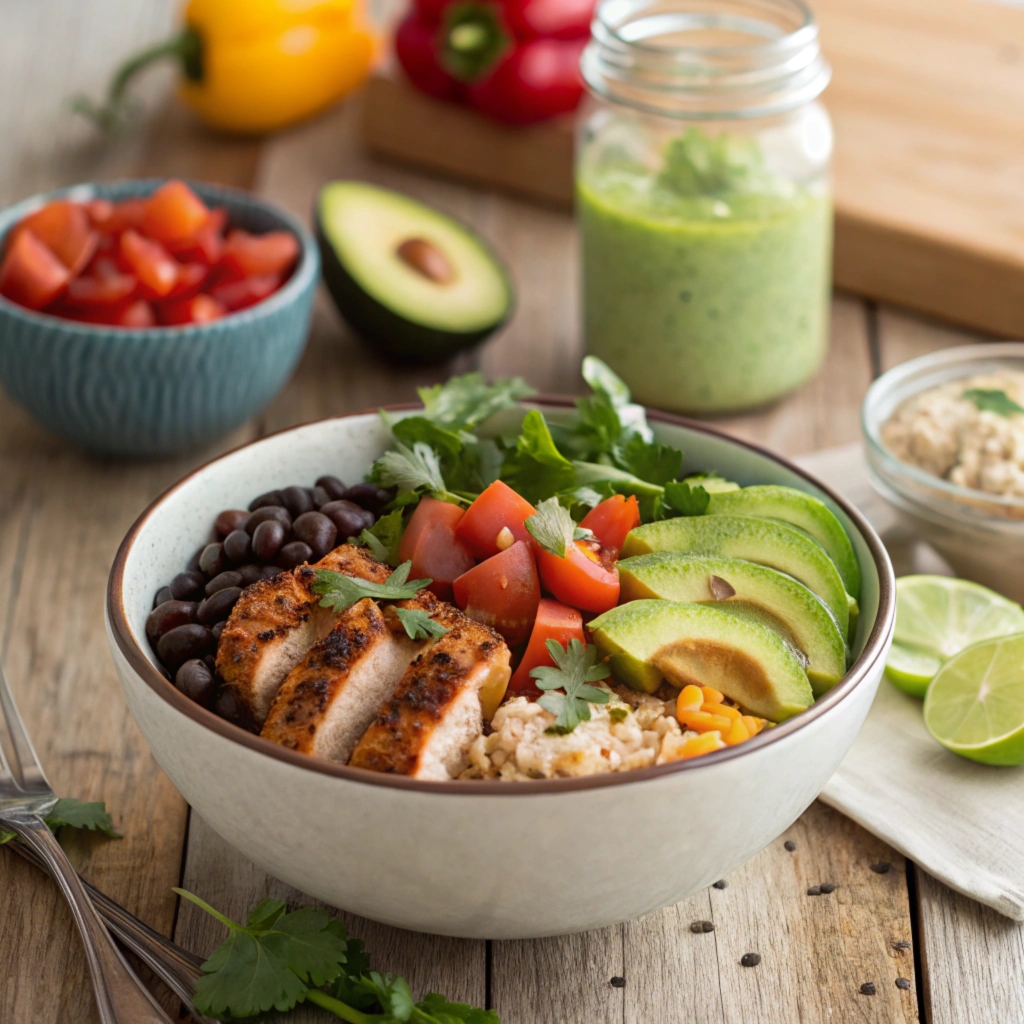Why People Choose Burrito Bowls Over Traditional Burritos
Burrito bowls have become an increasingly popular alternative to traditional burritos, offering a lighter and more customizable dining experience. By eliminating the tortilla, they reduce unnecessary calories and carbohydrates while still preserving the bold, satisfying flavors that make burritos so beloved. As a result, they cater to those seeking healthier meal options without compromising on taste.
Additionally, burrito bowls provide greater flexibility when it comes to dietary preferences. Whether someone follows a low-carb, gluten-free, or high-protein diet, the bowl format makes it easy to tailor ingredients to specific nutritional goals. Unlike traditional burritos, which can be challenging to portion control due to their tightly wrapped structure, burrito bowls allow for a more balanced distribution of ingredients. This means you can increase the amount of vegetables, adjust protein portions, or reduce high-calorie toppings as needed.
Another advantage of burrito bowls is their ease of customization. While a burrito must be carefully wrapped to hold all the ingredients together, a bowl offers more room to experiment with flavors and textures. Whether adding fresh greens, extra protein, or swapping out rice for cauliflower rice, the options are nearly endless. Furthermore, burrito bowls are often easier to eat, as they eliminate the risk of fillings spilling out, making them a convenient choice for both dine-in and meal prep.

The Essential Components of a Burrito Bowl
A great burrito bowl is built on a foundation of well-chosen ingredients. Each layer adds depth, texture, and nutrition, resulting in a balanced and satisfying meal.
- Base – The foundation of any burrito bowl can include options like white or brown rice, quinoa, cauliflower rice, or a bed of fresh greens. This layer provides carbohydrates for energy or a fiber-rich alternative for those looking to cut down on grains.
- Protein – Whether it’s grilled chicken, seasoned beef, shrimp, tofu, or black beans, the protein element ensures the bowl is filling and nutritious. Lean proteins contribute to muscle repair, while plant-based options add fiber and essential nutrients.
- Vegetables – A variety of vegetables, such as bell peppers, tomatoes, onions, spinach, and corn, enhance both flavor and nutrition. Fresh, roasted, or sautéed veggies contribute essential vitamins and minerals to the meal.
- Toppings – Avocado slices, guacamole, shredded cheese, salsa, or Greek yogurt add extra flavor and texture. While these toppings can boost taste, portion control is key to maintaining a balanced meal.
- Sauces & Seasonings – The right sauce ties the ingredients together. Choices like fresh salsa, cilantro-lime dressing, or a light drizzle of chipotle sauce can elevate the dish without overpowering the other flavors. Spices like cumin, paprika, or chili powder enhance the overall taste.
By carefully selecting and balancing these components, a burrito bowl can be both delicious and nourishing. Whether you prioritize flavor, nutrition, or convenience, this dish offers the perfect blend of all three.
Customization Options for a Burrito Bowl
One of the key appeals of a burrito bowl is its versatility. It can be customized to suit various dietary needs, flavor preferences, and levels of spice, making it a universal favorite.
Catering to Different Dietary Preferences (Vegan, Keto, Gluten-Free)
- Vegan: Build your bowl with a base of quinoa or greens, black beans, roasted veggies, avocado, and a drizzle of tahini dressing.
- Keto: Skip the rice and beans, and opt for grilled chicken, steak, or pork, paired with sautéed veggies, cheese, sour cream, and guacamole.
- Gluten-Free: Stick to naturally gluten-free ingredients like rice, beans, vegetables, and unprocessed proteins. Ensure sauces and dressings are also gluten-free.
Adding Regional and International Flavors
- Mediterranean-Inspired: Use couscous or cauliflower rice as a base, add grilled chicken, cucumber, tomatoes, olives, and top with tzatziki sauce.
- Asian Fusion: Incorporate sushi rice, teriyaki chicken, edamame, and sesame dressing.
- Caribbean Style: Try jerk-seasoned protein, coconut rice, and mango salsa for a tropical twist.
Spicing Up Your Burrito Bowl with Unique Ingredients
Add a creative touch with ingredients like:
- Pickled Vegetables: Pickled onions or jalapeños for tangy heat.
- Fruits: Diced pineapple, mango, or pomegranate seeds for a sweet contrast.
- Crunchy Additions: Tortilla strips, toasted nuts, or seeds for texture.
Nutritional Breakdown of a Burrito Bowl
Understanding the nutritional profile of a burrito bowl helps in creating a balanced and health-conscious meal.
Calories and Macronutrients in Common Ingredients
- Rice: About 200 calories per cup, mostly carbohydrates.
- Protein: Grilled chicken (120-150 calories per serving), black beans (110 calories per half-cup, high in fiber and protein).
- Veggies: Fresh or grilled vegetables add minimal calories but are nutrient-rich.
- Toppings: Cheese and guacamole add healthy fats but can increase calorie content significantly.
Health Benefits of a Balanced Burrito Bowl
- High in Nutrients: Packed with vitamins, minerals, and antioxidants from vegetables and beans.
- Rich in Protein: Helps with muscle repair and satiety when using lean meats or plant-based options.
- Fiber-Rich: Beans, quinoa, and veggies promote digestive health and keep you feeling full.

Tips for Making a Healthier Burrito Bowl
- Control Portions: Use smaller servings of calorie-dense toppings like cheese and sour cream.
- Choose Whole Grains: Substitute white rice with brown rice or quinoa for added fiber.
- Opt for Fresh Ingredients: Avoid processed additions to reduce sodium and additives.
- Use Lighter Sauces: Opt for salsa or Greek yogurt-based dressings instead of heavy creams.
With endless customization options and significant health benefits, a burrito bowl can be as indulgent or nutrient-packed as you choose. By tailoring your ingredients, you can create a bowl that meets your dietary goals and satisfies your taste buds.
Popular Variations of Burrito Bowls
Burrito bowls are incredibly versatile, allowing for countless variations that cater to different tastes and dietary needs. Here are some popular styles to inspire your next meal.
Classic Chicken Burrito Bowl
The classic chicken burrito bowl is a timeless favorite:
- Base: Cilantro-lime rice or brown rice.
- Protein: Grilled chicken seasoned with chili powder, cumin, and paprika.
- Toppings: Black beans, corn, pico de gallo, shredded cheese, guacamole, and sour cream.
- Sauce: A drizzle of chipotle crema or salsa verde ties the flavors together.
Vegan and Vegetarian Burrito Bowls
Plant-based burrito bowls are packed with flavor and nutrients:
- Base: Quinoa or mixed greens for a lighter option.
- Protein: Black beans, pinto beans, or roasted chickpeas.
- Toppings: Roasted sweet potatoes, sautéed bell peppers, fresh avocado, and mango salsa.
- Sauce: A tahini-lime dressing or spicy vegan cashew crema adds creaminess.
Low-Carb and Keto Burrito Bowls
For those following low-carb or keto diets, these burrito bowls are a perfect fit:
- Base: Cauliflower rice or a bed of leafy greens.
- Protein: Grilled steak, pork carnitas, or shrimp.
- Toppings: Sautéed spinach, avocado, shredded cheese, and sour cream.
- Sauce: Add a zesty chimichurri or garlic aioli for extra flavor.
Common Problems with Burrito Bowls
Despite their simplicity, burrito bowls can sometimes fall short due to common mistakes in preparation and ingredient selection.
Overloading with Calories and Fats
Adding excessive amounts of calorie-dense toppings like cheese, sour cream, and guacamole can turn a healthy burrito bowl into a high-calorie meal. Additionally, large portions of rice or fatty meats can quickly increase the calorie count.
Imbalance of Flavors and Textures
A poorly balanced burrito bowl can feel bland or overly intense. Using too many spicy or sour elements without complementary ingredients can overwhelm the palate, while a lack of crunch or creaminess can make the bowl feel monotonous.
Using Low-Quality or Prepackaged Ingredients
Prepackaged or low-quality ingredients, like canned beans with added preservatives or pre-cooked meats, can compromise the freshness and flavor of a burrito bowl. Fresh, high-quality produce and proteins make a significant difference in taste and texture.
By exploring popular variations and addressing common problems, you can elevate your burrito bowl experience. With the right ingredients and a thoughtful balance of flavors, textures, and nutrients, your burrito bowl will be a delicious and satisfying meal every time.
Solutions to Improve Burrito Bowl Quality
Creating a burrito bowl that’s flavorful, nutritious, and visually appealing requires careful ingredient selection and preparation. These solutions can help you elevate your burrito bowl experience.
Choosing Fresh and Organic Ingredients
- Produce: Opt for fresh, in-season vegetables to enhance flavor and texture. Organic options reduce exposure to pesticides and provide better taste.
- Proteins: Use high-quality, fresh meats or plant-based proteins, avoiding processed or pre-cooked options.
- Grains and Greens: Choose whole grains like quinoa or organic greens for a nutritious base.
Creating a Balance of Flavors and Nutrients
- Flavors: Balance spicy, sweet, tangy, and savory elements to create a well-rounded bowl. For example, pair spicy proteins with cooling ingredients like guacamole or sour cream.
- Nutrients: Combine carbs, proteins, and healthy fats in appropriate portions for a satisfying and energy-boosting meal.
Experimenting with Homemade Sauces and Salsas
- Homemade Salsa: Try fresh tomato salsa, mango salsa, or roasted chili salsa for variety.
- Creative Dressings: Whip up an avocado crema, chipotle mayo, or lime-yogurt dressing to complement the ingredients.
- Zesty Toppings: Add fresh lime juice, chopped cilantro, or a sprinkle of queso fresco for extra flavor.
How to Build the Perfect Burrito Bowl at Home
Crafting a burrito bowl at home allows for ultimate customization and control over quality and nutrition.
Step-by-Step Guide for Crafting Your Bowl
- Start with the Base: Choose rice, grains, or greens as the foundation.
- Add Protein: Layer with your choice of grilled chicken, beans, or tofu.
- Include Veggies: Add fresh or sautéed vegetables for color and nutrients.
- Top It Off: Finish with cheese, avocado, or guacamole.
- Drizzle with Sauce: Tie it all together with salsa, crema, or dressing.
Essential Ingredients and Tools for Preparation
- Ingredients: Fresh vegetables, quality proteins, and flavorful toppings like guacamole or shredded cheese.
- Tools: A cutting board, sharp knife, non-stick skillet, and meal prep containers for storing leftovers.
Meal Prep Tips for Busy Schedules
- Batch Cooking: Prepare large quantities of rice, beans, and proteins in advance.
- Chop Ahead: Pre-cut vegetables and store them in airtight containers for quick assembly.
- Store Separately: Keep wet ingredients (salsas, sauces) separate to maintain freshness.
By focusing on fresh ingredients, balanced flavors, and efficient meal prep, you can consistently create high-quality burrito bowls that suit your tastes and dietary needs. Whether it’s a quick lunch or a weekend dinner, these tips ensure a satisfying and stress-free cooking experience.
Burrito Bowl Ingredients from Restaurants vs. Homemade
Choosing between restaurant burrito bowls and homemade ones involves comparing the ingredients, customization options, and cost.
What Restaurants Typically Include in a Burrito Bowl
Restaurants often provide a variety of ingredients for burrito bowls, but they come with certain limitations:
- Base: White or brown rice, occasionally greens.
- Protein: Options like chicken, beef, pork, or tofu, typically pre-marinated and cooked in bulk.
- Vegetables: Limited to standard offerings like lettuce, tomatoes, and sautéed peppers.
- Toppings: Guacamole, cheese, sour cream, and salsa, often portion-controlled.
- Sauces: Pre-made dressings or salsas with limited ability to customize.
While convenient, restaurant options may contain higher sodium, preservatives, or added oils, and portion sizes may not align with individual dietary needs.
Benefits of Homemade Burrito Bowls
Homemade burrito bowls allow for complete control over quality and customization:
- Ingredient Quality: Use fresh, organic, or locally sourced produce and proteins.
- Dietary Preferences: Tailor the bowl to suit specific needs like low-carb, vegan, or allergen-friendly diets.
- Flavor Customization: Experiment with homemade marinades, salsas, and dressings for a unique taste.
- Healthier Choices: Reduce added fats, sugars, and sodium by preparing ingredients at home.
Cost Comparison: Dining Out vs. Cooking at Home
- Restaurant Bowls: Typically cost $8–$12 per bowl, with extra charges for add-ons like guacamole or double protein.
- Homemade Bowls: Ingredients for several servings cost around $15–$20, making it a more affordable option for families or meal prep.
Burrito Bowls for Special Diets
Burrito bowls are inherently versatile, making them ideal for adapting to specific dietary needs.
High-Protein Options for Fitness Enthusiasts
- Base: Quinoa, brown rice, or cauliflower rice.
- Protein: Double portions of grilled chicken, steak, shrimp, or tofu.
- Add-ons: Black beans, edamame, or roasted chickpeas for extra protein.
- Toppings: Avocado, salsa, and a dollop of Greek yogurt for a creamy, high-protein alternative to sour cream.
Gluten-Free Burrito Bowl Recipes
- Base: Use rice, quinoa, or greens—all naturally gluten-free.
- Protein: Ensure meats are cooked without sauces containing hidden gluten.
- Toppings: Fresh vegetables, guacamole, and cheese.
- Sauces: Stick to gluten-free salsas or homemade dressings.
Dairy-Free and Allergen-Friendly Ingredients
- Base: Opt for grains or greens that are allergen-free.
- Protein: Use grilled meats, beans, or plant-based proteins free from allergens.
- Toppings: Avocado, mango salsa, or pickled onions for creaminess and flavor without dairy.
- Sauces: Experiment with tahini, hummus, or vinaigrettes for a dairy-free twist.
By comparing restaurant and homemade options and exploring dietary adaptations, you can craft the perfect burrito bowl to meet your nutritional goals, taste preferences, and budget.
The Global Appeal of Burrito Bowls
Burrito bowls have evolved beyond their Tex-Mex roots, becoming a versatile meal enjoyed worldwide. Their adaptability makes them suitable for a variety of regional and cultural influences.
Regional Adaptations of Burrito Bowls
Across the globe, burrito bowls are being customized to reflect local ingredients and culinary traditions:
- Mediterranean Style: Couscous or bulgur base, grilled lamb or chicken, olives, cucumbers, and tzatziki.
- Asian-Inspired: Sushi rice, teriyaki chicken or tofu, edamame, and sesame dressing.
- Caribbean Fusion: Coconut rice, jerk chicken or shrimp, and mango salsa.
How Burrito Bowls Blend Cultures Through Fusion Elements
Burrito bowls have embraced fusion cuisine by combining ingredients and flavors from different cultures:
- Korean BBQ Bowl: Bulgogi beef, kimchi, and rice, topped with spicy gochujang sauce.
- Indian Masala Bowl: Spiced chickpeas, basmati rice, and a drizzle of yogurt-cucumber raita.
- Thai Peanut Bowl: Grilled tofu or chicken, rice noodles, and a rich peanut sauce.
Why Burrito Bowls Have Become a Worldwide Trend
- Versatility: Burrito bowls can be adapted to suit local ingredients and dietary needs.
- Health-Conscious Appeal: They offer a balanced meal with customizable options for clean eating.
- Ease of Preparation: Burrito bowls are simple to make, whether at home or in restaurants, making them accessible to a wide audience.
Environmental and Ethical Considerations
As burrito bowls grow in popularity, it’s important to consider their environmental and ethical impact.
Sustainable Ingredients for Burrito Bowls
- Plant-Based Proteins: Beans, tofu, and lentils have a smaller carbon footprint compared to meat.
- Seasonal Vegetables: Choosing in-season produce reduces the environmental impact of transportation and storage.
- Organic and Local Sourcing: Support eco-friendly farming practices and reduce pesticide use.
Reducing Food Waste in Homemade Burrito Bowls
- Batch Cooking: Prepare ingredients in bulk to minimize waste.
- Use Leftovers: Repurpose roasted vegetables or cooked grains from previous meals.
- Compost Scraps: Vegetable peels and stems can be composted instead of discarded.
Supporting Local Farmers with Burrito Bowls Ingredients
- Local Farmers: Buying from nearby farms reduces the carbon footprint and supports the local economy.
- Ethical Proteins: Choose free-range, grass-fed, or sustainably sourced meats and seafood.
- Fair Trade Products: Opt for fair trade-certified ingredients like coffee, chocolate, or spices to support equitable practices.
Conclusion: Why Burrito Bowls Are a Versatile and Delicious Choice
Burrito bowls offer a unique combination of adaptability, health-conscious appeal, and global inspiration. Not only can they be easily customized to suit different dietary needs, but they also allow for endless creativity in flavor combinations. Whether you prefer a protein-packed meal, a plant-based option, or a low-carb alternative, burrito bowls can be tailored to fit any lifestyle.
Moreover, their emphasis on fresh ingredients makes them a nutritious choice. By incorporating whole grains, lean proteins, and colorful vegetables, burrito bowls provide a balanced meal that supports overall well-being. Additionally, they eliminate the need for a tortilla, reducing unnecessary calories while maintaining all the delicious flavors of a traditional burrito.
Beyond personal health benefits, burrito bowls also align with sustainability efforts. Choosing locally sourced ingredients, minimizing food waste, and opting for plant-based proteins contribute to a more eco-friendly diet. Furthermore, preparing burrito bowls at home allows for greater control over ingredients, reducing reliance on processed foods and excess sodium.
Whether you’re experimenting with fusion flavors, supporting ethical sourcing, or preparing a quick and nutritious meal at home, burrito bowls provide endless possibilities. As a result, they have become more than just a passing trend. Instead, they stand as a modern culinary staple, resonating with people worldwide for their convenience, versatility, and health benefits.
You May also be Interested in:

